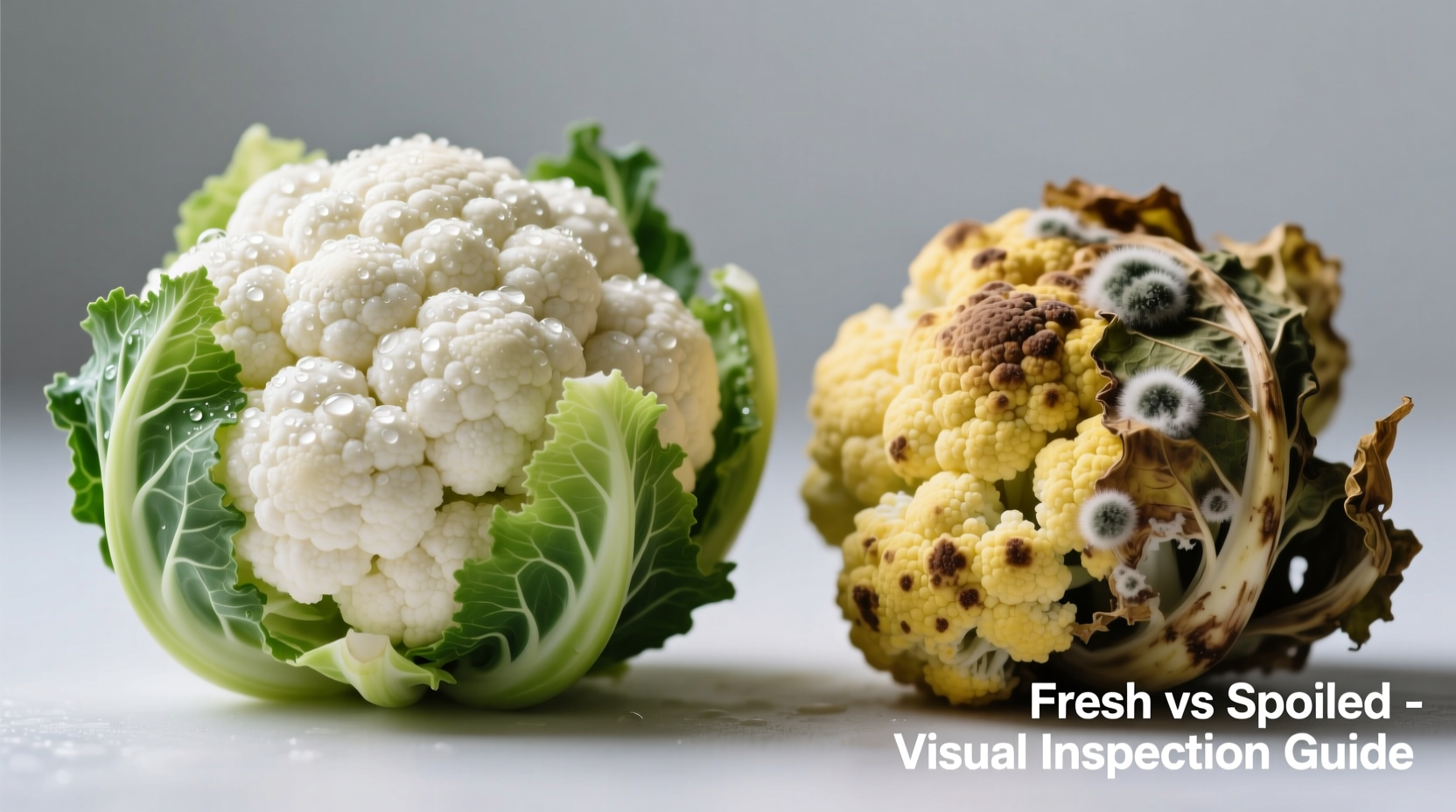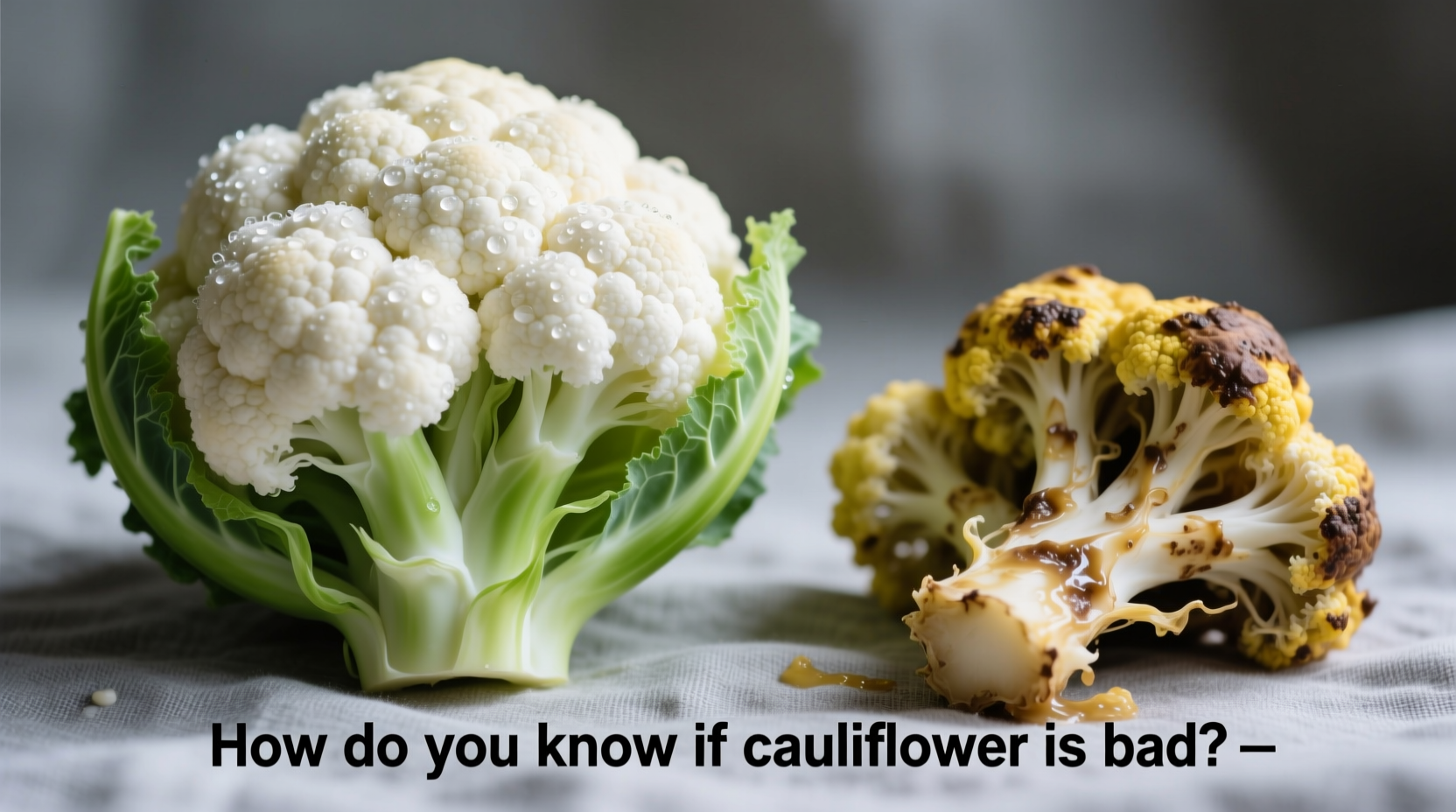Spot the Signs: Your Complete Guide to Cauliflower Freshness
Nothing ruins meal prep like discovering your cauliflower has spoiled. As a professional chef who's handled thousands of produce items, I've seen how often good cauliflower gets wasted due to uncertainty about freshness. This guide gives you the exact visual, textural, and olfactory cues to identify spoiled cauliflower with confidence—plus science-backed storage methods to maximize shelf life.
First Things First: The Visual Inspection Process
When you bring cauliflower home from the store, perform this quick visual assessment within the first hour. Proper identification starts with what you can see:
- Color changes: Slight yellowing is normal aging and still safe, but brown, black, or green spots indicate spoilage
- Mold presence: Fuzzy white, green, or black growth means immediate disposal
- Texture issues: Soft, mushy areas instead of firm curds
- Stem condition: Darkened, slimy base rather than crisp and pale
According to USDA food safety guidelines, any produce with visible mold should be discarded as mold can send invisible roots deep into the food. Unlike hard cheeses where you can cut away mold, cauliflower's dense structure makes complete removal impossible.
| Condition | Still Safe? | Action Required |
|---|---|---|
| Slight yellowing | Yes | Use within 1-2 days |
| Small brown spots | Yes (if isolated) | Cut away affected areas |
| Multiple dark spots | No | Discard entire head |
| Visible mold | No | Discard immediately |
| Slimy texture | No | Discard entire head |
The Smell Test: What Spoiled Cauliflower Actually Smells Like
Your nose provides critical information about cauliflower freshness. Fresh cauliflower has a mild, slightly sweet, earthy aroma. As it spoils, the scent changes dramatically:
- Fresh: Neutral or faintly vegetal scent
- Beginning to spoil: Slightly sour or acidic smell
- Definitely bad: Strong unpleasant odor resembling rotten eggs or sour milk
Food science research from Cornell University's Food Safety Lab confirms that odor changes in cruciferous vegetables like cauliflower occur when bacteria break down sulfur compounds. This process accelerates significantly once the vegetable passes its prime.

Texture Tells the Truth: The Touch Assessment
Don't skip the tactile examination—texture provides definitive evidence of spoilage:
- Press gently on multiple areas of the curds
- Fresh cauliflower should feel firm and spring back slightly
- Spoiling cauliflower develops soft, mushy spots that indent easily
- Danger zone: Slimy or sticky surface texture indicates advanced bacterial growth
Professional chefs know that texture changes often happen before visible spoilage appears. If your cauliflower feels different than when you purchased it—softer, wetter, or less crisp—it's time to reconsider using it.
Understanding Cauliflower's Natural Aging Timeline
Cauliflower doesn't spoil overnight—it progresses through predictable stages. Recognizing where your cauliflower falls on this timeline prevents unnecessary waste:
- Day 1-3: Peak freshness, crisp texture, pure white color
- Day 4-5: Slight yellowing may appear, still perfectly safe
- Day 6-7: Brown spots develop, texture begins softening
- Day 8+: Significant discoloration, possible odor changes
- Day 10+: High risk of mold, sliminess, and unsafe bacterial levels
Research from the FDA's Center for Food Safety and Applied Nutrition shows that proper refrigeration can extend cauliflower's shelf life by 3-5 days compared to room temperature storage. The critical factor isn't just time, but storage conditions.
Storage Secrets: Maximizing Your Cauliflower's Freshness
How you store cauliflower dramatically impacts its longevity. These evidence-based methods work:
- Refrigeration method: Wrap in damp paper towel inside perforated plastic bag
- Optimal temperature: 32-35°F (0-2°C) with high humidity
- Avoid: Sealed containers without airflow (traps moisture)
- Counter storage: Only for immediate use (within 24 hours)
University of California's Agricultural Extension program confirms that the damp paper towel method maintains ideal moisture levels—cauliflower needs some humidity but too much accelerates spoilage. This technique typically extends freshness by 4-7 days compared to standard plastic bag storage.
When in Doubt, Throw It Out: Food Safety Considerations
Consuming spoiled cauliflower risks foodborne illness. The most common pathogens found on spoiled cruciferous vegetables include:
- Salmonella (causes fever, diarrhea, abdominal cramps)
- E. coli (can cause severe stomach cramps, vomiting)
- Listeria (particularly dangerous for pregnant women and elderly)
The USDA Food Safety and Inspection Service emphasizes that cooking doesn't eliminate all risks from significantly spoiled produce. When mold appears or texture becomes slimy, no amount of cooking makes it safe to eat.
Special Considerations for Cut or Pre-Packaged Cauliflower
Pre-cut cauliflower products have different spoilage patterns:
- Bagged florets: Check expiration date and package integrity first
- Signs of trouble: Excess liquid in container, strong odor when opened
- Shorter shelf life: Use within 3-4 days of opening, even if date is later
- Never use if package is bloated (indicates dangerous bacterial growth)
Food safety experts at the FDA warn that pre-cut produce has higher contamination risks because the cutting process exposes more surface area to potential pathogens. Always inspect carefully before use.
Extending Usability: Creative Solutions for Aging Cauliflower
If your cauliflower shows early signs of aging but remains safe, try these chef-approved techniques:
- Slight yellowing: Steam or roast immediately—color improves during cooking
- Minor brown spots: Cut away affected areas; use remainder promptly
- Beginning to soften: Make cauliflower mash or soup (texture matters less)
- Last chance: Roast at high heat to caramelize and mask minor imperfections
Remember that cooking cannot rescue cauliflower with significant mold, strong odors, or slimy texture. When in doubt about food safety, always choose disposal over consumption.











 浙公网安备
33010002000092号
浙公网安备
33010002000092号 浙B2-20120091-4
浙B2-20120091-4